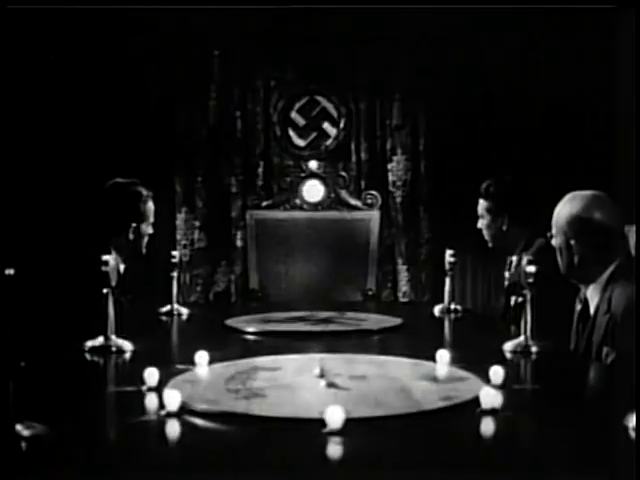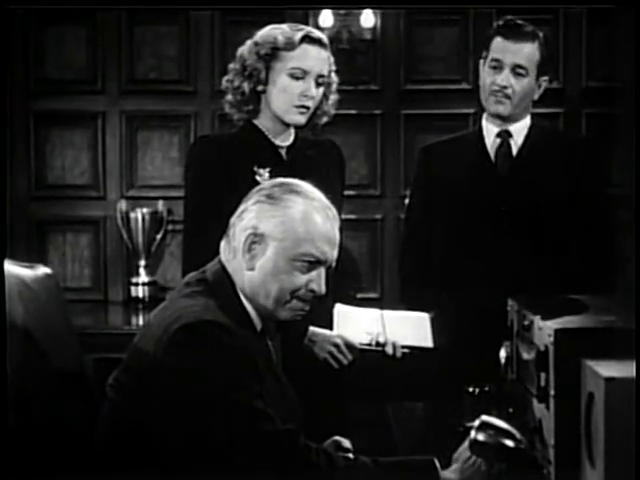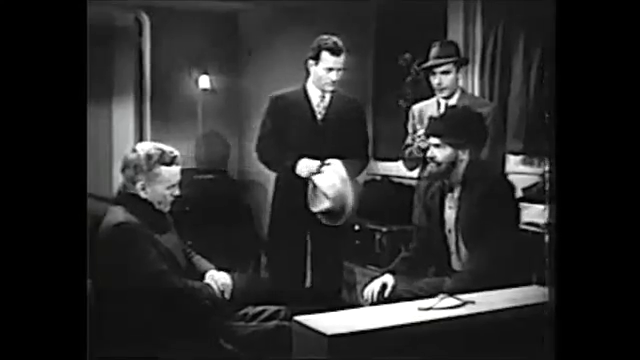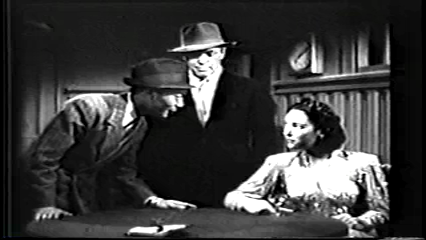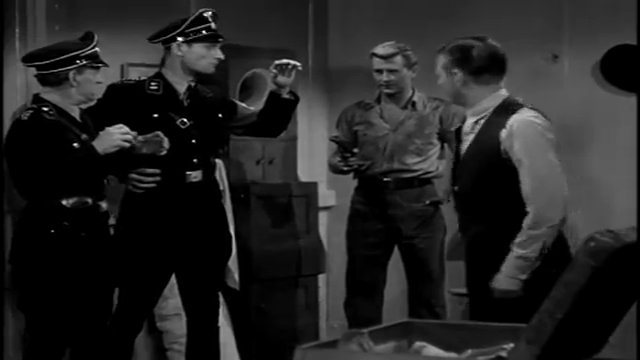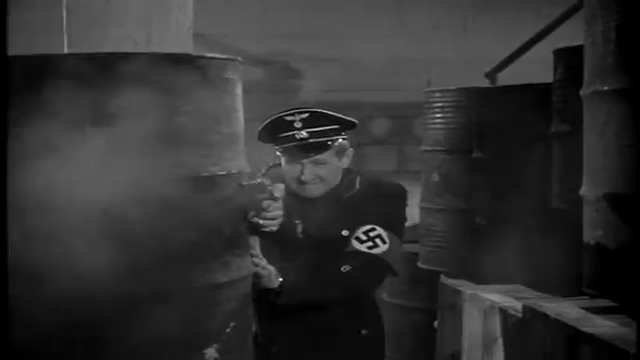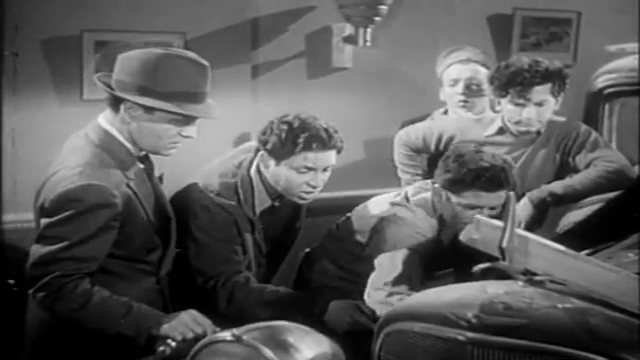-
#469 – The Master Key (1945)
The Master Key (1945)
Film review #469
Directors: Lewis D. Collins, Ray Taylor
SYNOPSIS: A secret Nazi organisation operating in the United States has kidnapped Professor Henderson in order to force him to finish his “auratron” invention that can make gold out of seawater, and use the gold to fund the Nazis operations. Tom Brant, an FBI agent, hunts down the Nazi spy ring with the help of Detective Jack Ryan and his contacts in the police force to find Professor Henderson and bring the Nazis to justice.
THOUGHTS/ANALYSIS: The Master Key is a 1945 serial released by Republic Pictures and comprised of thirteen chapters. The serial centres around a Nazi spy ring operating in the United States, who kidnap Professor Henderson and force him to complete his “auratron” invention, which can turn seawater into gold, which the Nazis will then use to disrupt America’s industrial might. The only thing standing in the way of their evil plans is FBI agent Tom Brant and his companions in the police department. The plot centres around this Nazi spy ring who identify themselves with a key that has the letter “M” and a number engraved on it. They are given their orders by the “Master Key,” who conceals their identity from even the group. That’s all the “Master Key” of the title refers to, and yes, it’s a rather uninteresting premise, given the keys serve no purpose other than to identify the spies, and are used at the start of each chapter to “summon” the master key who explains the plot. The main focus of the plot is Henderson’s invention which apparently turns seawater into gold, an idea which is sounds ridiculous even by the serial format’s standards. The chapters involve the typical plot structure of the heroes trying to rescue the professor and his invention…the amount of serials that enact this same plot is too many to count, and most of them do it better than this one. The plot has very little direction otherwise, and the back-and-forth between the protagonists and antagonists is painfully slow, and explained through long scenes of exposition that slow the pacing down to a crawl. There’s some cliffhangers that incorporate more impressive large crashes or explosions, but they are usually, and obviously, stock footage or models, and the fallout is never really shown, only explained further with the shot of a newspaper front page and even more dialogue.
The characters are the usual bunch you associate with the serial format: there’s the young male leads who get into the fights, the older men who serve as support, and some token women who get the role of journalist or secretary. The villains likewise are uninteresting and have no character or role other than being henchman. The main villain we never see until the very end, instead giving orders through some sort of radio…thing. There’s constantly very little for the viewer to grasp a hold of, and as such, it is difficult to maintain attention on the serial as a whole. There’s some supporting characters including a bunch of younger street-wise teenagers who help out under the watch of Aggie, a similarly street-wise woman. Again, none of the characters really stand out or do anything of merit.
Released in April 1945, The Master Key was released in the very dying days of World War II. As such, it is difficult to see how relevant the whole Nazi spy ring plot was. The wartime serials typically focused on Japan as the primary U.S. enemy, and choosing the Nazis as the villains is perhaps an odd choice at this time. Each chapter opens up with a disclaimer of sorts saying that the serial is fiction that “could never happen,” and states that it takes place in 1938 before the war even started. I assume this was in order to keep the serial in line with the requires of the regulatory bodies, perhaps setting it before the war was necessary to not give the illusion that the Nazis were still a threat to the US in the then dying-days of the war, and that the U.S. was too powerful for something like this to happen anyway. It’s interesting then that they allowed it during wartime: perhaps they needed people to be on their guard, but on the verge of the Nazis being defeated, the tone changed to saying that there was no way that anything like this could ever happen to America. It’s also interesting that the serial clearly identifies the enemies as Nazis and shows their flags in their hideout: again, most serials previously did not mention the Nazis by name or show any of their insignia, instead showing enemies that were working for a “foreign power” which obviously was meant to be the Nazis. Again I assume the requirements of the film regulators changed at the end of the war, and by being able to identify them and place them in the past, it signified that they were a product of history, and no longer a real threat. Also a small note concerning the invention that can apparently turn seawater into gold: it’s so outlandish and nonsensical even by serial standards that it’s very hard to take seriously.
Overall, The Master Key is a poor showing, released at the wrong time. It has very little direction in terms of story or characters, and the long-winded scenes of dialogue and exposition overshadow any action scenes. It exists at a strange point in history where the Nazis were no longer credible or interesting villains, but also before the post-war serials, which turned either to America’s military war heroes battling foreign spies (implied to be the soviet union) or more sci-fi adventures. As such, The Master Key falls between the cracks and fails to find very little relevancy or entertainment value.
-
#464 – The Great Alaskan Mystery (1944)
The Great Alaskan Mystery (1944)
Film review #464
Directors: Lewis D. Collins, Ray Taylor
SYNOPSIS: Dr. Miller, along with Dr. Hauss, has invented a new death ray called the paratron. However, Dr. Hauss is secretly a Nazi spy, who intends to steal the death ray to give to his home country. Jim Hudson, an adventurer of sorts, tells Miller that the material he needs to complete the paratron may be found in the Alaskan mines, and so they set off there, only to have their plane crash on the way…
THOUGHTS/ANALYSIS: The Great Alaskan Mystery is a 1944 serial released by Universal pictures comprised of thirteen chapters. The serial centres around the invention of a death ray called the “paratron,” invented by Dr. Hauss and Dr. Miller. However, they are having trouble completing it. Jim Anderson, an adventurer who knows Dr. Miller’s daughter Ruth, visits and remarks that a rare mineral that can be found in mines in Alaska might be what they are looking for. They all set out on a boat to Alaska, but various machinations are at work, as Dr. Hauss is secretly a Nazi spy, and intends to steal the paratron for his own country, getting the Captain of the ship to aid him in his scheme. The ship sinks and the cast are forced to survive in the Alaskan wilderness until they are rescued. The first two or three episodes are quite varied and dump the cast straight into the Alaskan wilderness doing what you would expect them to di in Alaska: getting caught in the snow, visiting Inuit natives, and such. After chapter three, the serial settles down into a more typical format, with the heroes and villains engaging in a back and forth as they try to get a hold of the paratron and stop each other. In terms of story then, it’s a standard serial affair. The stakes aren’t particularly high as everything revolves around this death ray which while is indeed powerful, doesn’t seem as revolutionary as some other inventions used in these serials (maybe because the idea of the death ray has been done to death). Also this is a wartime serial, and the stakes here probably pale in comparison to the real war going on at the time. There’s also perhaps something to be said for the fact that the setting of Alaska makes the serial feel somewhat removed from any wider context. However, the serial does make good use of the Alaska setting, as we get a decent amount of shots of the wilderness and unique set-ups in the mountains and snow, even if they rely heavily on stock footage.
The cast for this serial is fairly large. However, none of them really stand out, and fall into very typical serial roles. The cast does however, consist of a number of popular and well-known actors of the time, which enhances the serial with some decent performances. You have the typical protagonist, the sole female character, and the elderly scientist, along with the villains and their henchman. There’s also plenty of characters pretending to be helping the heroes when they are the villains. it all adds up to quite a mystery, but never really flows into a coherent experience as all the characters are easy to get mixed up and don’t form their own unique performance.
As mentioned, the depictions of Alaska are perhaps the most unique part of the serial, with plenty of scenic shots, lumberjacking, and wilderness sets that make it look the part. The dialogue is what mainly drives the story though, as with most Universal serials. There’s not a lot of action scenes outside of some classic shoot-outs and chase scenes, and again that is typical of a Universal serial, which usually are less action-oriented than the ones from rival serial producer Republic. Overall, The Great Alaskan Mystery has many of the serials tropes that it needs to, but fails to bring it’s busy story and large cast together to create anything special. It’s got everything it needs, but is ultimately a bit forgettable, leaving it to be remembered as just another average serial amongst the many of the format.
-
#436 – Don Winslow of the Navy (1942)
Don Winslow of the Navy (1942)
Film review #436
Directors: Lewis D. Collins, Ray Taylor
SYNOPSIS: Commander Don Winslow of the U.S. Navy is assigned to stop a foreign spy ring that is intent on sabotaging the construction of a new naval base on an island in the Pacific Ocean. Winslow and his friends battle against the head of the spy ring, known only as “The Scorpion” and seek to foil his evil schemes across land, sea and air…
THOUGHTS/ANALYSIS: Don Winslow of the Navy is a 1942 film serial comprised of twelve chapters, and is based on the U.S. navy approved comic strip character of the same name. The story concerns Commander Winslow being assigned to stop a spy ring from sabotaging the construction of a new naval base in the Pacific Ocean. There’s not really anything special to say about the plot; it is a fairly standard setup that is found in nearly every wartime serial. While it is to be expected that these serials served as propaganda at the time for the war effort, Don Winslow was a character that was sanctioned and approved by the U.S. navy, so while this means that the uniforms and representation of the navy are fairly accurate, it probably means that there was a lot of oversight regarding what he should and shouldn’t do. I think this is probably the reason why he rarely gets into fistfights or other messy situations (although he does more so than in the sequel, where he never gets rough with anyone). Whereas the pre-wartime serials had plenty of lead characters that would don masks to conduct vigilante missions against the enemy, pre and post-war serials typically reserved such costumes and roles for the villains, while making leads that were victorious American soldiers.
The characters are about what you’d expect from a serial, with Winslow being the face of the navy in the serial, and being expectedly heroic and patriotic. His fellow navy officer “Red” serves as his friend and backup in the action scenes, and Mercedes Colby fills the single female role. The villains are also pretty standard, with a bunch of henchmen being led by a man who is only known as “The Scorpion,” who as usual is a white man in make-up to “look” Japanese. We only ever see him, however, on a screen in the spy’s secret base, and there is no final showdown with him (he is however, confronted in the sequel). One very distracting thing about The Scorpion is that with the close-ups of his face on the screen, you can clearly tell the actor is reading his lines as his eyes move left to right, which is quite distracting.
There’s plenty of stock footage used of navy vessels and submarines that makes the action a bit more exciting, which again is probably owed to the fact that the serial had the involvement of the U.S. navy (although I’m led to believe that the submarine that shows up in the stock footage is a British submarine). The models used for the airplanes and such, are far less convincing. The cliffhangers usually end up with Winslow getting caught in an explosion or a collapsing building, and usually walking away with nothing more than a limp. Again, fairly standard resolution to the chapter cliffhangers, and obviously they’re not going to show a navy officer getting seriously hurt if they’re being portrayed as strong invincible heroes of the war. Overall, Don Winslow of the Navy is what you would expect from a wartime serial. It’s not particularly interesting and neither does it offer anything new or original. The use of stock footage of ships and navy vessels gives it a larger sense of scale, but it’s a product of wartime propaganda that serves almost exclusively that purpose, and not worth seeking out.
-
#435 – Don Winslow of the Coast Guard (1943)
Don Winslow of the Coast Guard (1943)
Film review #435
Directors: Lewis D. Collins, Ray Taylor
SYNOPSIS: Following his success at Pearl Harbour, navy officer Don Winslow is assigned to the U.S. coast guard to stop Japanese saboteurs led by the mysterious “Scorpion.” Winslow’s new mission is to stop the saboteurs from disrupting the Coast Guard’s operations and to find their secret island base from where they are conducting their nefarious schemes.
THOUGHTS/ANALYSIS: Don Winslow of the Coast Guard is a 1943 Universal Pictures serial comprised of thirteen chapters. It is based on the comic strip Don Winslow of the Navy, approved by the U.S. Navy. The story of the serial opens with Commander Don Winslow, along with his buddy “Red,” being assigned to the U.S. Coast Guard to defend against foreign spies and saboteurs, in particular, a Japanese spy ring led by a man known only as “The Scorpion” (in ties of war the Coast Guard becomes under the direct command of the navy, which explains why Winslow is so easily transferred and keeps his rank and uniform etc.). Each chapter brings a new scheme for Winslow to foil as the spies try and sabotage facilities to prepare for a ground invasion. It’s all the sort of thing you would expect from a wartime serial such as this. Being a character that was approved by the U.S. navy, it should also be no surprise that this is a big propaganda film for the service, and as such the serial is full of ships and submarines engaged in warfare through the use of stock footage. Furthermore, the anti-Japanese rhetoric is pretty severe, again, probably to reinforce the idea of them as enemies of the U.S. at a time of war. Overall, the story isn’t anything special, as a lot of the wartime serials urge viewers to remain vigilant of spies to help their country.
The characters are all a pretty standard bunch. Don Winslow is obviously the heroic and ideal Navy officer who will defeat the enemy and claim victory for his country, as well as inspire people to support and join the navy as well. His friend “Red” serves as his sidekick to join in on the action scenes, and not much else. Mercedes Colby plays the typical token female role, and takes on a similar typical role as a nurse (although this is a little different than the job of journalist or secretary that female characters usually get in these serials). The villains are also nothing special, comprising of American actors in make-up to “look” Japanese, and The Scorpion himself having little presence. On the other hand, there are a fair amount of actual Asian actors to play some background Japanese soldiers, and actually speak some Japanese (even though the pronunciation is a little off from what I can tell).
The production values are fairly decent for the format, which perhaps reflects the use as wartime propaganda. I am left wondering just how much involvement the Navy had with the serial’s production, as there is a lot of stock footage of Navy battles and cannon fire, particularly in the first chapter, where this footage is used so overwhelmingly it is nearly impossible to follow the plot. Another curious thing to note is that there are practically no fistfights anywhere in the serial, which is basically unheard of in the format. Perhaps getting involved in such brawls would have looked unsightly for a Navy officer? Either way, that doesn’t stop Winslow shooting or pistol-whipping his enemies. Overall, Don Winslow of the Coast Guard follows many wartime serials, but is rather less than subtle about its use as military propaganda. The over reliance on stock footage makes the plot difficult to follow at times, although it makes a change to see action scenes that don’t revolve around poorly-choreographed fistfights. The inherently racist and nasty anti-Japanese rhetoric in particular means that the serial has not aged well, but you can see why it invests so much in it, given that the attack on Pearl Harbour would still have been raw in America’s consciousness, and the serial knows to play on that. I would not recommend this serial, as overall it is a bit too much of a story-related mess and a product of its time.
-
#429 – The Mysterious Mr. M (1946)
The Mysterious Mr. M (1946)
Film review #429
Directors: Lewis D. Collins, Vernon Keays
SYNOPSIS: Anthony Waldren has assumed the identity of Mr M in order to steal the invention of a revolutionary submarine engine, undertaking a series of murders to do so, and using a new drug he has invented that can hypnotise people into doing his bidding. However, a person claiming to be the real Mr M contacts Waldren and starts giving him orders under the threat of exposing his crimes. Federal agent Grant Farrell, whose brother is one of Waldren’s victims, takes up the case of stopping Mr M, aided by fellow agent Kirby Walsh and insurance investigator Shirley Clinton.
THOUGHTS/ANALYSIS: The Mysterious Mr. M is a 1946 serial comprised of thirteen chapters. It is the 137th, and final serial that Universal Pictures ever produced. The other two big serial producers (Republic and Columbia Pictures) would produce serials for a few more years. The story of Universal’s swansong serial centres around Anthony Waldren, who attempts to steal Dr. Kittridge’s invention: A submarine engine that is far faster than anything currently in operation, Following a series of murders, someone claiming to be the real Mr M begins sending Waldren phonograph records outlining instructions for getting a hold of the blueprints for himself, forcing Waldren to work for him lest he expose his scheme. Federal agent Grant Farrell is assigned to stop Mr M and prevent the submarine engine from falling into the wrong hands. The premise sounds simple enough, and similar to a lot of other serials, but the main problem with the story is just how convoluted it becomes. Waldren, who faked his own death years before, uses the “Mr M” identity to undertake his crimes, until the “real” Mr M starts to blackmail him to follow his orders. His Sister also secretly works with him to cash in on their grandmother’s insurance policies, who works with insurance investigator Shirley Clinton, who also teams up with Grant Farrell, the federal agent and protagonist who is out to stop Mr M. All of these connections make the plot incomprehensible to follow at points, and simply doesn’t make very interesting viewing. The best serials are simple to follow, with heroes vs villains battling it out, but with enough space for imagination to make them more interesting. In The Mysterious Mr M, there is a severe lack of the latter, as most scenes consist of men in suits engaging in dialogue that explains the plot, and even then, it’s still difficult to follow. The plot involving a submarine engine seems entirely without consequence, as we don’t even see a submarine until the very last minute.
As mentioned, the web of character relations is convoluted and difficult to follow, without adding anything of value to the story. The identity of Mr M is kept secret until the last chapter as usual, and doesn’t really offer anything of consequence. The rest of the cast are rather dull and forgettable, with no real unique qualities, and it’s really not worth going through them. In adding all of these character relations, the serial simply forgets to make any of them interesting. The cliffhangers are also fairly standard, while using model buildings and vehicles to create huge explosions or crashes. They are always resolved, however, by having the heroes walk away with nothing more than a sore head or dizziness. The setups are very repetitive for each chapter, as plot and counter-plot between the heroes and villains gets tiring quickly. The only one which is mildly interesting is the heroes following a hidden tracking device on a map which resembles modern day GPS, which would have been more interesting and novel at the time.
Given that this is Universal Pictures final serial, it can safely be said that they ended on a whimper rather than a bang. The studio that gave us Flash Gordon had clearly run out of steam at this point. With the advent of television, perhaps Universal foresaw that viewers would not want to go to the cinema every week for twenty minutes when the format could be accomplished without such effort in their living rooms. After the second world war, the serial format of heroes fighting spies and villains working for foreign powers undoubtedly became dramatically less relevant, and people probably wanted to see something different. Columbia and Republic Pictures continued producing serials that featured military heroes that celebrated the military victories in the war, and also returning to some more sci-fi settings that popular serials had before the war, but The Mysterious Mr. M offers none of that; it offers very little of anything in fact. It’s a sad end for Universal’s serial producing machine that, while guilty of rehashing the same stories and characters for over ten years and over a hundred serials, undoubtedly entertained viewers and sparked the imaginations of young moviegoers. The Mysterious Mr M seems unsure what to do in the post-war era without big foreign enemies or looming war to provide the backdrop for it’s story. Regardless, there’s no excuse for the severe lack of imagination in the settings or characters, and the boring dialogue that re-explains the plot constantly, and even then fails to make it make sense. A momentous occasion in the history of the serial format, but one ultimately that is best forgotten.
-
#426 – Secret Agent X-9 (1945)
Secret Agent X-9 (1945)
Film review #426
Directors: Lewis D. Collins, Ray Taylor
SYNOPSIS: Shadow Island is an island in the Pacific ocean owned by American gangster Lucky Kamber. He has maintained his island’s neutrality during the war, but this has also meant it has become a hotbed for spies from all countries to visit and engage in shady activities. Secret Agent X-9 is sent by America to investigate a Japanese plot concerning something known only as element 722, teaming up with a Chinese agent and Australian spy to take on the Nazi and Japanese forces on the island.
THOUGHTS/ANALYSIS: Secret Agent X-9 is a 1945 serial comprised of thirteen chapters. The film takes place on Shadow Island in the Pacific Ocean, which has retained it’s neutrality on the ongoing World War II thanks to it’s owner Lucky Kamber striking a deal with the Japanese government. However, this neutrality brings in all spies from all warring nations, leading to a hotbed of subterfuge and sabotage. Japanese scientist Hakahima discovers an element known only as “722″ has the capability to replace airplane fuel when mixed with water, thus supplying an infinite fuel source. The head of the Japanese on the island, Nabura, devises a plan to send a criminal to the United States, whose face is altered by plastic surgery, to imitate the professor who discovered element 722 and get the formula from his office, which the professor himself believes to simply be a failed experiment. When Australian spy Lynn Moore learns of this, she informs her superiors, and the Americans send in secret agent X-9 to foil the plot, teaming him up with Chinese agent Au Fong. The setup to this serial is certainly one of the more interesting of the serials I have seen, with this island providing a unique setting for all the warring nations to scheme against each other. The back-and-forth plot of the protagonists sneaking around and attempting to foil the villains schemes is more typical of the serial format. However, there’s a good variety of settings and characters that keeps things interesting, alongside the tense relations between enemies that have to keep in line with the island’s neutrality. There is a lot of dialogue that simply repeats the plot points, but that’s not too uncommon for serials where viewers may not have watched all of the chapters.
The characters are a pretty interesting bunch, and offer a decent amount of variety. Many of the nations involved in the war are represented within these characters, with their own personalities that make them stand out. Secret Agent x-9 himself is played by a young Lloyd Bridges, and is definitely a strong lead, with his shiny blond hair, buff physique and charming personality. Au Fong, the Chinese agent, is played by Keye Luke, who played Kato in the Green Hornet serials, and is a good sidekick. Lynn Moore as the Australian double agent (who has an American accent) who pretends to work for Japanese forces with her radio broadcasts has a fair amount to do, particularly in comparison to other “token females” that are usually found in these serials. There’s also the Nazis that are fairly convincing in their full uniforms, as usually they are only referred to as a “foreign power” and never in the full uniforms. This goes a long way in giving the serial a convincing setting. The main protagonist is Nabura, a Japanese woman, who is played by a white American actress in makeup. This is not unusual at the time, but at least most of the other (male) Japanese characters are played by Asians. Her character comes across as sufficiently scheming and evil, but her portrayal by the actress constantly has her eyes half closed and looking at the floor as if she is reading her lines that are offscreen, which is distracting. Lucky Kamber, the owner of the island, in his portrayal in keeping the island neutral in the war, also has an interesting role as he tries to keep everyone else from tearing each other up. Other minor characters such as Solo, who sits at the same spot playing tiddlywinks for most of the film, and the French hotel owner Papa Pierre, also have their own personality and look which makes them fairly memorable and allow them to bring their own unique flavour to the scenes they are in. It is very rare to find a serial with such a varied cast and to make them interesting enough across the entire serial, but this serial definitely goes a lot further than others.
The setting of Shadow Island provides a decent variety of locations, from the casino, the Nazi ship and the hotel run by Pierre. They are all fairly distinct from one another, so the viewer can keep track of where they are. As mentioned, the characters all have a distinct appearance, from the Japanese soldiers to the Nazi uniforms, their is little doubt about who is who. Probably the weaker elements of the serial is the lack of action sequences, which revolve around the typical fistfights and car chases that you would expect to see. Most of the serial is focused on the intrigue and espionage played out through the characters, so it is important to follow the story. The cliffhangers aren’t too interesting, but there’s one or two novel traps the heroes have to escape from. Overall though, I think Secret Agent X-9 has an interesting and quite unique setup, alongside an array of distinct characters. The heroes are likeable, and the villains despicable, with a few morally grey characters as well to make things interesting. Some elements of the plot are a bit more typical, and the constant re-iteration of plot points can be a little tiresome. There’s less emphasis on action and more on espionage so perhaps some people (particularly younger viewers) may find it a little tiresome, but it distinguishes itself enough to make it a good and fairly unique example of the genre.
-
#416 – Junior G-Men of the Air (1942)
Junior G-Men of the Air (1942)
Film review #416
Directors: Lewis D. Collins, Ray Taylor
SYNOPSIS: “Ace” Holden and his friends hang out at his Father’s airstrip, hoping to enter the local air race while Ace’s younger brother Eddie is inventing a new plane engine. Ace and his friends witness a bank robbery, and when they refuse to cooperate with the local G-man, they try and find the robbers, not realising that they belong to the “Order of the Black Dragonfly” a foreign organisation that is attempting to sabotage American industry and pave the way for an invasion. Ace and his friends join up with the junior G-men in order to combat this threat to themselves and their country…
THOUGHTS/ANALYSIS: Junior G-men of the Air is a 1942 film serial composed of twelve chapters, and the third to feature the young group of actors The Dead End Kids and The Little Tough Guys, although none of the serials are connected or have the same characters. This time, the kids are help to salvage junk at the airfield owned by the Father of one of the boys, Ace. While out collecting junk in their truck, they witness a robbery on a bank by a gang who steal their truck to make their getaway. Ace manages to get a strange broach of one of the men, but when the local G-man, Don Ames asks for the kids cooperation, they refuse due to their distrust of law enforcement. It turns out the robbers belong to a group known as the “Order of the Black Dragonfly,” a fifth column gang of saboteurs looking to destabilise American society to pave the way for a foreign invasion. As the serial progresses and Ace’s younger brother Eddie is kidnapped, the kids join up with the junior G-men, led by Jerry Markham, to find the gang and put a stop to them. The film’s plot is quite similar to Junior G-men, the first serial featuring the group of young actors, but while that one had a setting on land, and Sea Raiders focused on the sea, this one is centred around the air and aeroplanes, although there’s not too much action in the air. At least each of them have something unique about them. Other than that there’s not too much special about the story, but as with its predecessors, having the leads be these young, unruly boys rather than the typical all-american hero offers something a little different to the vast majority of serials.
The characters of the young actors are quite similar to the ones they played in the previous serials, but I suppose they are hired to play those specific roles. The leader of the gang, Ace, is the usual agitator and instigator, although he appears a bit more tidy than the previous serials for reasons I’ll get into below. At least his name isn’t Billy this time as well. Huntz Hall as “Bolts” plays his usual idiots sidekick routine without any real surprises, and “Stick” and “Greaseball” play mostly supporting roles, but they do have more lines and action than in the previous serials. While the kids are still troublemakers and somewhat hostile to any person of the law, they are less abrasive and unlikable than they were in previous serials, which again I’ll get into below. Other characters including “Double Face” Gordon add some variety to the line-up, while Don Ames as the G-man provide the more typical straight-laced law enforcement hero. Once again there’s no real female characters aside from a minor secretarial role, as it’s clear the serial is aimed at young boys of a more rebellious nature. The villains are classed as saboteurs, destroying America from within, and are obviously meant to be representing Japan. As is usual for these serials, The Japanese characters are all played by white Americans in make-up to “look” Japanese, which is not a good look to say the least, and a practice which sadly persevered for years in the film industry. Other than that, there’s nothing too remarkable about them.
Let’s get into the main aim of this serial: it is a giant propaganda piece for young Americans to serve their country in any way possible. By the time of the serials release, the U.S. had officially entered the Second World war after the attack on Pearl Harbour, and Anti-Japanese sentiment as overwhelming. A lot of these serial have secret Japanese societies of saboteurs fuelling this sentiment, as well as convincing the public to suspicious of everything around them. That the rough antics of the lead kids and their hostility to law enforcement is toned down in this serial compared to the previous ones is probably due to delivering this message that everyone must help their country in any way they can, in fact there’s multiple scenes that explicitly deliver this line. The final chapter of the serial is one big battle where the army storms the farm where the villains have set up a base, making it look like a battlefield and displaying the glorious victory of American troops. At the end everyone remarks about how vigilant they must be against enemies from within who threaten to destroy the American way of life, when they get new that Pearl Harbour has been attacked and they must now get ready for war and remain more vigilant than before. A lot of wartime serials push this messaging, but this serial is definitely more blatant about it than others I’ve seen. Maybe because it’s aimed at the younger rebellious generation that might be more reluctant to get behind their country. nevertheless, this makes for a much more interesting finale than you get in most serials, with the large scale battle making for an interesting payoff, even if it feels like mostly stock-footage not involving most of the main cast.
Overall, Junior G-men of the Air is a decent enough serial with plenty of action to keep younger viewers entertained. The overwhelming sense of wartime propaganda that fills some of the scenes is a bit much (although there’s definitely worse), and the frankly racist depiction of Japanese people as sneaky and devious is badly outdated, which was sadly not uncommon in film for a significant period of time. It doesn’t offer much that the previous two serials featuring the young actors doesn’t, but like the other two, at least does something a little different to most serials.

